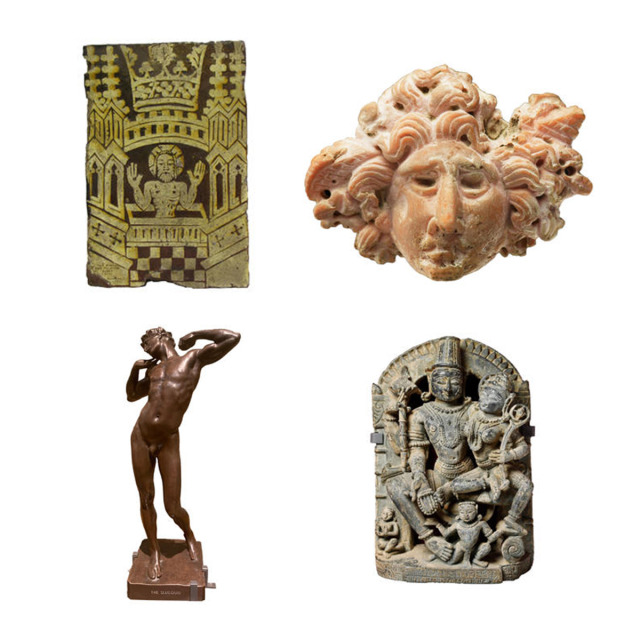#ancienthistory
Happy #stpatricksday! Here I am next to an #oghamstone. Want to see more cute pics of me in this outfit, learn more about Ogham Stones, or just impress your friends with some #trivia about #irishhistory while you’re at the pub tonight? Head to my website (link in bio).
…
*pst* this post is free ;)
…
#oghamstone #ireland #travel #miniskirt #skirt #snowflowerbikini #history #ancienthistory #archaeology #stpattysday #stpatricksdayoutfit #sheerbikini #countryside #barefoot #blondehair #blonde
Post link
MUSEUM SECRETS: A Miniature Masterpiece


“At first glance, we might assume that this copy of a German print belongs in the Ashmolean’s collections of European art. But no. This is an Indian drawing, and is housed here in the Eastern Art department. And it’s not just any Indian drawing, but one of the greatest of the Mughal Empire."
In the series 2 finale of our Museum Secrets podcast, Keeper of Eastern Art Mallica Kumbera Landrus introduces us to the child genius behind this tiny drawing. This piece of paper, only 10cm high, tells a story of cultures embracing each other across vast distances and the curiosity of one exceptional 13-year-old boy in Mughal India, 421 years ago.
Listen to ‘A Miniature Masterpiece’ here, or wherever you find your podcasts. -> https://www.ashmolean.org/museum-secrets
OUR MUSEUM: OUR VOICES

Part of the beauty of an object, or a museum collection, lies in its capacity to respond to more than one gaze and to unlock more than one story. We’re committed to hearing and telling as many of those stories as possible.
One of the ways we’re doing this is through ‘Our Museum: Our Voices’, a programme in which we asked 24 students to write alternative labels for objects on display in our galleries. The labels are written from personal experience as well as expertise, with participants considering their ethnicity, gender and sexuality in responding to the collections.
Keep an eye out for 'Our Museum: Our Voices’ labels as you roam the galleries during your next visit, and explore a virtual exhibition of the objects and their labels here: https://www.ashmolean.org/omov
Happy Birthday, Ashmole!

Today is the 404th birthday of Elias Ashmole, the founder of the Ashmolean Museum.
Ashmole was a well-connected antiquary, government official, collector and student of alchemy. His own collection of coins and a magnificent library of books and manuscripts had been dramatically expanded in 1659 with the addition of a collection – both man-made and natural – assembled from around the world by John Tradescant the Elder and his son, John Tradescant the Younger.
Ashmole donated most of his collections to the University of Oxford in 1677, and when the Ashmolean opened in 1683, it was not just a repository and place for research and teaching but also a public museum. Ashmole’s vision ultimately laid the foundations for museums as we know them today.
Though our collection has evolved considerably, Ashmole’s founding principle remains: that knowledge of humanity across cultures and across times is important to society.
Oil in canvas painting by John Riley, 1681-82.
Not All Heroes Wear Capes

“Not all heroes wear capes: some ride around on a Mobile Elevated Working Platform, wear a back-mounted vacuum and have been said to resemble a young Sigourney Weaver from the final scenes of ‘Aliens’."
While the Museum has been closed, our technician Tim has been taking advantage of the quiet galleries to do some rather unconventional cleaning and maintenance.
In this week’s story, find out how he’s been caring for our collections behind the scenes and helping us to prepare for reopening.
Read 'Not All Heroes Wear Capes’ here: ashmolean.org/article/high-level-cleaning
NEW MAP: Europe 305: Second Tetrarchy (1 May 305) https://buff.ly/2SMcCAk In 305 Diocletian and Maximian both retired, setting a precedent in the hopes of stabilizing the office of Emperor and preventing further succession crises. Galerius and Constantius became the new Augusti and appointed Maximinus Daza and Valerius Severus as their Caesars. #4thcentury #constantine #diocletian #tetrarchy #ancientrome #easternromanempire #europe #europeanhistory #historias #historicalplace #historygram #historylover #historymajor #historymatters #historynerd #persianempire #sasanian #history #mapmaking #maps #may #may1 #ancienthistory #roman #romanempire #romanhistory #romans #welovehistory #westernromanempire #newmap (at Milan, Italy)
https://www.instagram.com/p/CQ17EDXLkmv/?utm_medium=tumblr
Post link

The oldest known temple in the world, Göbeklitepe, Urfa.

- The great temple of Athena the Parthenon at the Acropolis of Athens

Glass pomegranate. Greek, Hellenistic period, 2nd c.BC. Phoenix Museum.

Atlas / or Silenus, Theater of Dionysus, Acropolis, Athens, c. 4th century BC.
A golden Roman helmet, circa 4th century CE.


Horse Handle Lapis Lazuli Dagger khanjar, Persian, 19th Century CE.
The Al-Sabah Collection, Kuwait

Roman road at Dion, 1st-2nd c. CE

Detail of a bronze statue of Standing Parvati. Chola period, c.1200 CE, Tamil Nadu, India

Massive Roman aqueduct built in Segovia, Spain by emperor Trajan (r. 98-117 CE).

View of the Temple of Hephaestus at the agora of Athens

The ancient theatre of Dodoni, Epirus, Greece.

The Caryatids, Acropolis of Athens, Greece.

An aerial photo of Luxor Temple, Egypt.

Ship with helmsman, rowers and warriors. Greek scarab from chalcedony. 525-500 BC. MET Museum.

Melian marble relief with Heracles, Deianira and the centaur Nessus. 460-450 BC. Arch. Museum of Piraeus, Greece.

Pompeii, the city that fell under lava with a sudden explosion. Italy

Quetzalcoatl (feathered serpent), detail from Teotihuacán, Mexico.

The Minoan palace of Knossos, Crete, Greece

The Ancient Theatre of Epidaurus (4th century BC), Argolis, Greece



